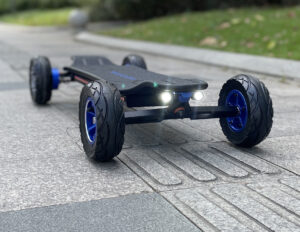Introduction
For e-skateboarding devotees, your electric skateboard isn’t just a hobby – it’s a passion. As you plan your next adventure, visions of coasting new cities or cruising pristine beaches likely dance in your mind. While the thought of hitting the open road excites you, the realities of navigating airport security may ground your dreams.
The big lithium-ion batteries powering your e-skateboard hit daunting aviation safety limits. While mini versions may pass inspection, standard batteries often exceed permitted carry-on thresholds, posing in-flight fire risks.
But don’t shred your boarding pass just yet. This guide will help you understand the risks involved with batteries, how to pack properly, and the safest ways to ship items. This way, you can confidently travel to new places without any worries with your reliable electric skateboard close at hand.

Safety Concerns With Electric Skateboards Air Travel
Aviation authorities have legitimate concerns regarding damaged, defective, or mishandled lithium-ion batteries posing fire and explosion risks in flight. Airlines thus enforce strict regulations on e-skateboard batteries to minimize hazards. To further understand the manifestation of these risks, it’s crucial to delve into some common causes of lithium-ion battery incidents on e-skateboards:
- Physical damage – Internal short circuits can occur if a battery is punctured, crushed, or similarly impacted. This may lead to overheating, leakage of hazardous substances, or combustion.
- Overcharging – Excessive heat generation is possible when overcharging lithium-ion batteries. While modern safeguards help prevent this, using the proper manufacturer-approved charger remains critical.
- Overheating – Exposure to high temperatures, extended usage cycles, or faulty charging equipment can also overheat batteries. Potential consequences range from swelling and leakage to ignition.
- Short circuits – If the positive and negative terminals contact metal, rapid discharge and dangerous heat buildup may ensue. This could ultimately result in a fire.
- Manufacturing defects – Improper insulation, internal particles, uneven coatings on electrodes, or other anomalies occasionally arise. Leading brands implement stringent quality control to mitigate such risks.
Given the immense peril of inflight lithium battery incidents, airlines justifiably enforce precautions to safeguard aircraft and passengers.
Why Are There Concerns?
The lithium-ion packs commonly used in electric skateboards can range from 3000-5000mAh, far exceeding FAA allowances for carry-on batteries of under 100 watt-hours. This is because skateboard batteries need to provide the high power output and long-range riders expect. Unfortunately, damaged or overheated lithium cells carrying this much energy pose a fire risk on planes. That’s why compliance is critical.

International Regulations on Electric Skateboards Air Travel
TSA (US)
- Lithium-ion batteries must be 100Wh or less
- Lithium metal batteries limited to 2g of lithium per battery
- Both can be carried in carry-on and checked bags
EASA (EU)
- Lithium-ion batteries must be 100Wh or less or get operator approval
- Between 100-160Wh requires operator approval
- Over 160Wh not permitted
- Metal batteries 2g limit
FAA (US)
- Lithium ion must be 100Wh or less per battery
- Installed in devices also allowed
- Steel packaging required over 8g for cargo
IATA (International)
- Lithium ion limited to 100Wh in carry-on, 160Wh in cargo
- Metal batteries limited to 2g
- Cargo-only packages limit of 35kg for lithium batteries
- Additional documentation required for quantities over allotted limits
The FAA, TSA, IATA, and EASA all have a maximum limit of 100Wh for lithium-ion batteries in carry-on luggage on aircraft. Some mini electric skateboards have smaller batteries under 100Wh, which could potentially be carried on depending on airline rules. But most standard e-boards would not qualify.
International organizations and national regulators publish guidelines that often change. Policies also vary between airlines, with some like United and Southwest explicitly prohibiting electric skateboards. Travelers must contact their specific airline well in advance to understand current rules for their itinerary.
Can You Check an Electric Skateboard on a Plane?
Most airlines allow you to check an e-skateboard in luggage. However, precautions are necessary. You’ll need to remove the battery and place it in a protective case before packing since batteries can pose risks if damaged. Checking is generally safe, but be aware there’s still potential for harm to the board during transit, so pack it very securely.
Can You Take an Electric Skateboard Carry-On?
Bringing an e-skateboard as a carry-on is usually prohibited. Air travel rules restrict the battery capacity for carry-on items, typically to 100Wh or less out of safety concerns. But e-skateboard batteries are designed to have the larger capacity to power the motor over long distances. Since exceeding the carry-on limits could present a fire hazard, airlines will likely prevent you from bringing it on board.

Shipping as an Alternative
To avoid carry-on size and battery capacity constraints, you can ship your e-skateboard as air cargo. However, specialized rules apply. The lithium battery must be packaged separately in certified hazardous materials containers. You’ll need to fully declare and document the battery when arranging shipping. While safer than flying with it, shipping can take more time to reach the destination compared to carrying on.
Tips for Safe Transportation
- Opt to check your e-skateboard instead of carrying it on. Checking avoids size and battery capacity limits.
- Use plenty of padding around the e-skateboard when packing it. Bubble wrap or foam will help prevent damage.
- Put the lithium battery in a sealed plastic bag inside your luggage for extra protection.
- Clearly label the checked luggage box, showing it contains a lithium battery. This alerts airport staff.
- If it doesn’t fit in a suitcase, look into air or ocean freight cargo shipping. More room means better safeguarding.
- Remember, you’re legally responsible for any incidents if regulations aren’t followed. Do your homework to stay compliant.
- Adhere to all manufacturer instructions on transporting the e-skateboard and removing the battery.
Conclusion
E-skateboarding’s growth has outpaced aviation’s safety regulations on these devices. Rules stay in flux, requiring close review before flying with e-boards. Checked luggage offers the best option, but meticulous battery precautions are mandatory for safety. Carry-ons remain a non-starter due to fire risks from oversized batteries. Cargo shipping, while slower, provides a compliant transportation method. With diligent adherence to protections and procedures, you can ride your e-skateboard worldwide. But disregarding regulations makes you liable, grounds your board, and jeopardizes safety for all.

FAQs
- Q: What should I do if my skateboard’s battery is larger than 100Wh?
- A: Batteries bigger than what’s allowed for carry-ons will need to be shipped as cargo or taken out and packed very safely in checked baggage. You could also get a smaller battery just for traveling by air if needed.
- Q: How do I properly pack my skateboard and battery for a flight?
- A: First, remove the battery, wrap it up securely, and put it in an approved container like a sturdy plastic case. Pad your skateboard well, cover any exposed electronics, and check both items securely in your luggage.
- Q: How can I prepare my electric skateboard for air travel?
- A: If you’re permitted to bring your e-skateboard on the plane, follow a few key steps to prep it for travel. Most importantly, check the manufacturer’s instructions and follow them exactly. Typically, you’ll need to partially discharge the battery to around 30-50% capacity since fully charged batteries are at higher risk. Pack your e-skateboard in a well-padded, protective case or bag with the power switch shielded so it won’t turn on by accident. Bring any tools required to remove the battery if the airline needs you to.
- Q: What alternatives are there if flying isn’t possible?
- A: Look into shipping via ground or sea freight, taking a train if allowed, or breaking your journey to comply with battery rules. As a last resort, rent or purchase local transportation at your destination.
- Q: Where can I find the latest aviation safety guidelines?
- A: Consult websites like the FAA, IATA, EASA, TSA, and individual air carrier policies. Regulations change frequently, so confirm the rules shortly before traveling.
Read More
- Electric Skateboard Wet Riding Maintenance – Ecomobl
- Control Electric Skateboard With Phone – Ecomobl
- Best Electric Longboard Skateboard For Under 700 – Ecomobl
- Riding Electric Skateboard Without Battery – Ecomobl
- Electric Skateboards Transform Daily Ride – Ecomobl




